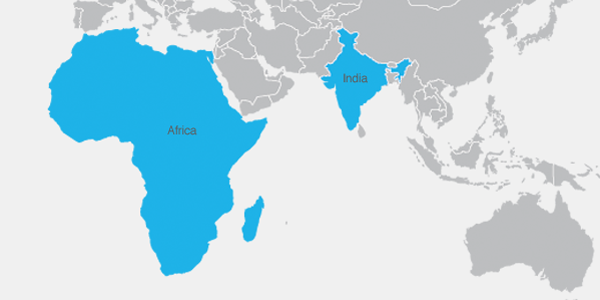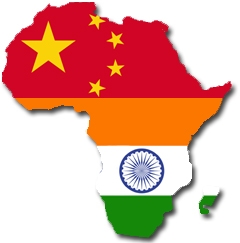Note: This is second and final article, analysing African economy and relating it to Indian Economy. Read it here – Africa – Land of opportunities for India (Part I) | UjwalAndhra Pradesh
Initiatives taken by Government of India engaging with Africa:
- India-Africa Forum Summit.
- 2nd India-Japan dialogue on Africa was held in New Delhi in 2011. It is an institutionalised event held biannually.
- IGNOU to establish Indo-Africa Virtual University.
- Team -9 (Techno-Economic Approach for Africa India Movement) framework to enhance commercial cooperation with West Africa (Burkina Faso, Chad, Cote d’Ivoire, Equatorial Guinea, Ghana, Guinea-Bissau, Mali, Senegal).
- Putting in place US$500 mn Lines of Credit (LOC) and identifying priority sectors in the 8 countries which would be financed out of the LOC.
- The Ministry of Commerce and Industry, GOI, Ministry of External Affairs, Export-Import Bank of India and Africa Development Bank initiated the India- Africa Project partnership Conclave, in New Delhi. The Conclave created platforms for decision maker from Africa countries to meet heads of India companies involved in engineering, consultancy, construction and supply of project goods, etc.
- The India-Brazil-South Africa (IBSA), Trilateral Commission of the foreign ministers of India, Brazil and South Africa (2004) would meet in regular intervals.
- In Uganda, Indian technology led to nearly three times more electricity to be generated, from 300 MW to 1000 MW than had been planned at Karuma project.
- New Delhi is also planning to set up over 100 training institutes that seek to foster the rise of a middle class in Africa and provide the African youth opportunities for self-advancement.
- India is the third largest contributor UN Peace-Keeping Operations in Africa with more than 9300 peacekeepers deployed in various UNPKO in fragile and conflict ridden states in Africa.

India’s Economic relations with Africa:
- India has acquired observer status in a number of regional organisations in Africa such as the Common Market for Eastern and Southern Africa, the Southern African Development Community and the Economic Community of West African States
- In 2002, launched the Focus Africa Programmeinitially focused on sub-Saharan Africa, with emphasis on seven major trading partners in the region and was broadened in 2003 to accommodate North Africa.
- The Confederation of Indian Industry, in partnership with the Indian government, Export–Import Bank of India (EXIM) and the African Development Bank initiated the India–Africa project partnership conclaves. Since 2005, four conclaves have taken place in New Delhi, along with mini-conclaves in Africa. These conclaves serve as a meeting ground between decision makers and industrialists from African countries and heads of Indian companies involved in various projects in Africa. The latest conclave was 10th CII EXIM bank conclave held in New Delhi in 2014.
- India launched an initiative in 2004 called Techno-Economic Approach for Africa–India Movement (TEAM–9), together with eightenergy and resource-rich West African countries viz. Burkina Faso, Chad, Cote D’Ivoire, Equatorial Guinea, Ghana, Guinea Bissau, Mali, Senegal, and India.
- In 2008, the India–Africa Forum Summit: which involves co-operation in capacity building, agricultural infrastructure development, health and food security, energy security and technological co-operation
- China’s deepening engagements in Africa has eclipsed India’s growing relationship with the continent.
- ONGC has invested in oil production & refinery in Nigeria and Sudan through OVL
- The Southern African Development Community (SADC) is an inter-governmental organization with a goal to further socio-economic cooperation and integration as well as political and security cooperation among 15 Southern African states, The Government of India signed the Memorandum of Understanding on economic cooperation with SADC on 14th Oct, 1997.
- Indian Technical and Economic Cooperation (ITEC) programme, which launched in 1964 provides training, deputation of experts and implementation of projects in African countries
- Pan African e-Network Project (PAENP), India has set up a fibre-optic network to provide satellite connectivity, tele-medicine and tele-education to countries of Africa. M/s. TCIL, a Government of India undertaking, is implementing the project on behalf of Government of India. (The project cost is approximately Rs. 542 crores.)
A comparison of China vs. India in Africa:
China’s role in Africa: before becoming the economic power, China successfully implemented the massive Tanzam rail project between Tanzania and Zambia.
China’s $200bn trade with Africa is way ahead of India’s $46 bn.

“Forum on China-Africa Cooperation” – started in 2000 with 5 summits held till now.
- Unlike China’s venture in Africa, that has focussed on extractive resources, oil and infrastructural projects, India chose to focus on capacity building as the defining template of its engagement with Africa.
- Chinese companies are active across the continent with big infrastructure projects, including ports, railways and sports stadiums. By contrast, Indian initiatives are led by individual companies looking to expand in sectors such as telecom, agriculture, the automotive industry and education.
- India’s all-round cooperation with Africa through People2people, govt2govt, & business2business, is different from China’s, largely, top-down Govt2Govt approach.
- Like China, India organises summits to engage Africa. Deals worth millions have been discussed, but implementation is poor.
- However, the Chinese companies go with their own people to do the work in Africa, leaving the locals in the lurch, unlike India, which employs locals.
- China excels in large infrastructural projects while the Indians have an edge in ICT, capacity building and training, and emerging areas like floriculture.
- The Indian ability to relate to Africans is also much greater, which is why non-Indian MNCs prefer to use Indians as managers for projects involving interactions with local officials and populations.
- India’s democratic culture and consultative approach make it an attractive partner for African nations looking to enhance their own skills.
Form Africa’s perspective, both India and china have core competencies which may complement each other. Thus, Africa is looking forward to do business with both the countries at the same time and there seems to be enough room for the two. But India should not become complacent as African economy will start to emerge in the world set-up, competition from the world will be stiff. India should also avoid the path of exploitation which other big powers have taken. India’s participative model will slowly but steadily build a strong bond between India and African nations on the foundation of mutual trust and benefit rather than the acquisitive approach of China.
Four powers are increasingly influencing African growth – USA, Europe(France), China and India.How should Africa benefit from its interaction with these powers ?
Let us turn to growth story of Africa, and the hurdles it has to cross
For more analysis of African economy, refer to first article – Africa – Land of opportunities for India (Part I) | UjwalAndhra Pradesh
Challenges to African growth story
Africa should be treated as the “Child to be nurtured” rather than as the “orphan that should be taken care of” mentality. This shows a paradigm shift in treating it as a respectable member of the world Fora and giving it’s due space to ask and do for things.
Relying on the success stories of the East might be counter-productive, sometimes, because certain part of that came as the patronage that was offered to the Eastern countries, owing to their geographical advantage, international dynamics and political interests.
How to bring in solidarity amongst the African countries? Most of them are torn with internal serious skirmish that are only pushing their vision hundred years back from now on. A common currency like that of Europe is definitely not a good option. What could be the other ways ? Coming to projection of democracy as a viable option for development, Eastern Asia is already split. Leadership, does it need guidance from external frontiers, or how to elevate strong leaders in these countries?
The main issue that’s troubling its reconstruction is, the eventual failure if the super structure is built on the present premises. Or starting everything from the scratch for a perfect future, will deny the till date work. It is in these dangerous junctures that Africa is facing doldrums.
Africa being a land of wonders has always been on the receiving end of ideas or strategies. Somewhere, the world has failed to trap their techniques and concepts on a bigger picture. That lack of balance is another reason for the lack of deserved limelight. Ex: The crop Insurance Agricultural Insurance Initiative, Kilimo Salama, Kenya
Also, HDI indicator as per the latest Human development report also suggests that, no African country has very high human development index and an analysis is given below, Africa has following Distributions.
| Category | Number of Countries | Growth Strategy |
| Very high human development | 0 | |
| High human development | 5 | Already Heavily urbanised. Big consumer markets. |
| Medium human development | 12 | Myrdal’s growth strategy – increase the backwash and spread effects, by improving linkages |
| Low human development | 35 | Breaking Vicious Circles – low savings, small and inefficient makets, poverty trap. |
Another important concern is about rapid capital inflows relative to size of some of the African countries. Recent events indicate that liberalizing capital flows can pose particularly severe risks and costs. This could lead to situation similar to East Asian economic crisis. Therefore, the key lesson for Africa illustrated by the crisis is that, the importance of developing a robust financial systems and exchange rate regimes in the light of liberalisation and opening up of economy. A stable political setup can lead to macroeconomic stability and prudent financial regulations are needed to sustain the growth rates in Africa.
Another issue is Africa’s inattention to the violence—often tinged with religious extremism—that grips many regions, is causing serious damage to its economy. Same was the case, when Ebola pandemic spread across many countries. Then, people hesitated to even step out of their house, for day to day activities. All Economic activities came to stand still, as people to people contact was avoided, at least in the core regions.
Also, there is lack of rapid Industrialization in many African countries to tap in rich natural resources. Therefore, African governments need to shift the economic growth trajectory from simply focusing on commodities to a more diversified economic base that adds value to these products. Achieving this will necessitate an efficient and robust infrastructure which is yet another challenge that African leaders must face up to and address them quickly. Countries such as China and India have been providing investment such as Pan African e-Network Project (PAENP) by Government of India which has set up a fibre-optic network to provide satellite connectivity, tele-medicine and tele-education to countries of Africa.
So to Conclude,
Many other factors will continue to influence development in Africa – not least how successfully these lessons are actually adapted and applied. Africa should not be risk-averse, inward-looking and fearful of change.
But the bottom line is that Afro-optimism, an optimism that sees sustained economic growth as the future of Africa is not merely sentimental, and India should actively engage with Africa, at-least now.

